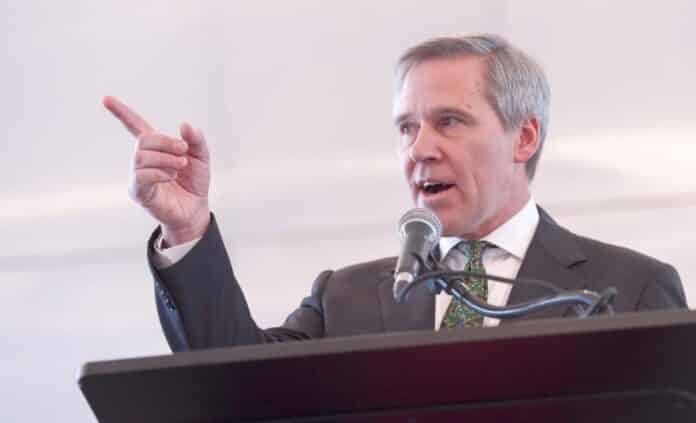
COLUMBUS, Ind. — Congress could help accelerate the development and adoption of green hydrogen and other cleaner energy as companies, including Columbus-based Cummins Inc., confront the challenges of curbing greenhouse gas emissions in a world shifting away from fossil fuels.
That was among the main points in Cummins Vice Chairman Tony Satterthwaite’s testimony before the Senate Committee on Energy and Natural Resources Tuesday, where he discussed areas where the federal government could make a difference and the Columbus-based company’s path to zero emissions.
Satterthwaite, who attended the Senate hearing virtually, said significant public support is needed from the federal government, national labs and research institutions for the U.S. to “achieve this path to zero in a way that is cost effective, timely and promotes U.S. jobs and manufacturing.”
“This is critical to success on our path to zero emissions,” Satterthwaite said.
Cummins, as well as many companies that sell or use diesel engines, find themselves at a crossroads of sorts now, as alternative fuel technology grows in viability and concerns about climate change continue to reshape how companies and policy makers think about energy consumption.
Diesel fuel is refined from crude oil and is used to fuel compression-ignition engines named after their inventor, Rudolf Diesel, according to the U.S. Department of Energy.
Most freight and delivery trucks, buses, farm and construction vehicles, as well as some cars and pick-up trucks, use diesel engines, the U.S. Energy Information Administration says.
Hydrogen can be burned without emitting carbon dioxide into the atmosphere, and “green hydrogen” is hydrogen produced from renewable energy sources.
Two of the clean energy technologies that Cummins officials have discussed publicly include electrolyzers — which use electricity to split water molecules into hydrogen and oxygen — and hydrogen fuel cells — which essentially put the two elements back together to produce electricity and power a motor.
But the shift to green hydrogen has several challenges, including that the technology “needs a different infrastructure than we have today,” which Satterthwaite described as a “chicken-and-egg problem.”
That infrastructure would include more fueling stations across the country.
Currently, there are just 46 retail hydrogen fueling stations in operation in the U.S. — 45 in California and one in Hawaii — according to the U.S. Department of Energy’s Alternative Fuels Data Center.
As of mid-2020, there were at least 30 stations in various stages of planning of planning or construction, including 12 planned in the northeastern U.S., according to the U.S. Department of Energy.
“Infrastructure is a fundamental chicken-and-egg problem,” Satterthwaite told The Republic after his Senate testimony. “…Without infrastructure, you don’t get adoption, and without adoption, nobody invests in infrastructure. And so we see a definite role for the federal government to kick start that chicken-and-egg cycle and provide some incentives for early investment in infrastructure, perhaps even before there’s significant adoption in the market, because without that infrastructure, we won’t get adoption.”
Earlier this month, President Joe Biden met with Republican and Democratic lawmakers at the White House to maintain bipartisan momentum for a new infrastructure program, The Associated Press reported.
In July, Biden laid the groundwork for an infrastructure package by proposing $2 trillion in “accelerated” investments to shift to cleaner energy, including clean energy deployment, building charging stations for electric vehicles, supporting public transit and repairing roads and bridges, according to wire reports.
There is a need for infrastructure spending, according to the American Society of Civil Engineers, which graded the nation’s infrastructure as a lackluster “C-” earlier this month, according to wire reports.
The group said $5.9 trillion must be spent over the next decade for safe and sustainable roads, bridges and airports. That recommendation is about $2.6 trillion more than what the government and private sector spend.
Last week, Rep. Greg Pence, R-Indiana, introduced legislation in the House that would expand eligibility for certain U.S. Department of Energy loans to include projects related to hydrogen production, delivery, infrastructure, storage, fuel cells, among other items.
The Department of Energy’s Loan Program Office has billions of dollars in loans available for energy projects, according to the office’s website.
In November, Cummins unveiled plans for how it intends to ramp up its fuel cell and hydrogen production business in the coming years, including investing in and producing technology that company officials believe will help the company secure its place in a world that is shifting away from fossil fuels.
Cummins Chairman and CEO Tom Linebarger projected in November that the company’s electrolyzer business will have about $400 million in annual revenues within the next five years.
Additionally, the company plans to ship fuel cell systems for at least 100 trains, mainly in Europe, by 2025, the company said.
In November, the company said it had more than 2,000 fuel cell installations globally and more than 500 electrolyzer installations in fueling stations on five continents, including the first fueling stations in Scotland, Sweden, Norway and Southeast Asia.
Satterthwaite said he would like to see the federal government give more assistance to projects that create green hydrogen.
“You have to invest in making the fuel,” Satterthwaite said. “You have to invest in making the hydrogen. So if you think about natural gas, there’s a whole separate industry that develops natural gas… But we have to create a whole new industry to make hydrogen if we’re going to have a green economy that runs on hydrogen. The specific area that I would like to see the federal government do is pay more attention and give more assistance to projects that create green hydrogen.




